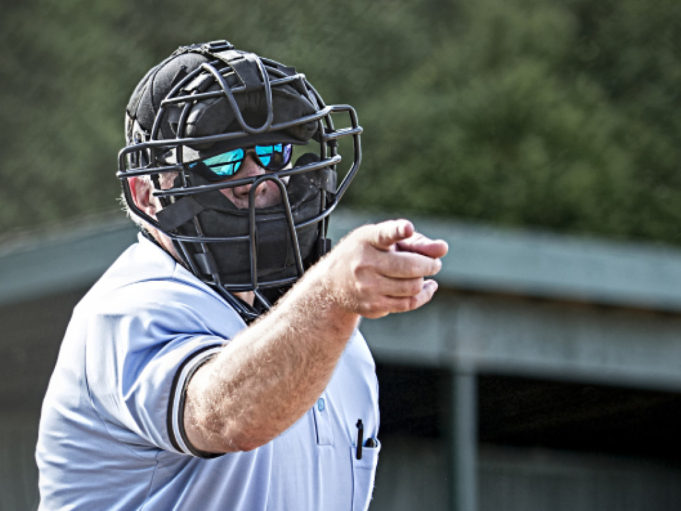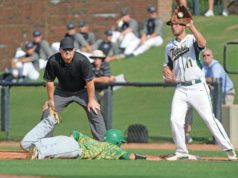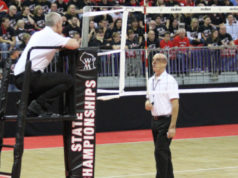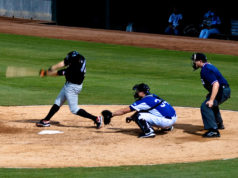By Mike Droll
Whether it’s at an umpiring clinic, professional umpiring school or just learning from a buddy who is getting you ready for your first Little League game, umpires starting out are taught how to throw that right fist into the air to make a strike call. They usually look very mechanical and a little robotic. Rookie umpires are trying to get used to seeing the pitch, making the decision and coming up with the strike signal.
However, regardless of where you started learning the basic mechanics of umpiring, there comes a point when umpires learn to move beyond the basics and begin to develop their own style for making calls. Nowhere is an umpire’s style more evident than in how he makes the strike call. So the question for the developing umpire to ask, “Do I use the hammer or the point?”
An argument can be made that taking a step back and pointing toward the first-base side is most easily seen by players, coaches and fans. Those who advocate that style make it a point to emphasize that is especially true of umpires who are not overly tall. In keeping with that thinking, some umpires will step back and point to the third-base side when a left-handed batter is up to make the signal even more visible, especially to defensive players whose vision might be blocked by the batter.
The “point” is the style that is used almost exclusively by umpires who work from the scissors stance, or by those few umpires left who still work the knee stance.
If making a signal that is most easily seen by all participants and fans is the primary consideration, then it should be the required mechanic at all levels. End of debate, right? To quote Lee Corso, famous ex-football coach and current television football analyst, “Not so fast, my friends!” There is definitely a science to good umpiring. However, I would maintain there has to be an art, too.
What looks good for a particular umpire while he calls strikes can go a long way toward convincing observers that he is getting them right. What looks good for any particular umpire is something that will be a function of his body type, athletic ability and fluidity of motion.
The “hammer” style involves coming straight out of the box stance with a fist that looks like you are banging on some object with the butt end of a hammer’s handle. There are many variations of that “hammer” signal. Some like to come straightforward from the right shoulder, some bring their fist to a stop more in front of their torso anywhere from face level to closer to the mid-section. Even more distinctive is the “hammer” that simulates a punch being thrown like the right cross of a boxer.
How does one find that perfect style that is the right fit? Like anything else, it takes practice. I tell umpires I work with to practice in front of a mirror. What looks and feels good to you will likely have the same effect on others when they see you work.
In the Midwest, where I live, as cable television was getting its start in the 1980s, baseball fans got a steady diet of Cubs and Braves games as part of their basic subscription. Prior to 1999, MLB umpires were contracted by the leagues they worked (NL or AL). Since the Braves and Cubs were both NL teams, I saw mostly NL umpires on a regular basis. There was a point when I could turn on a game and tell you after one strike call who was working the plate for that game. Whether it was Frank Pulli’s “punch” or Dutch Rennert’s exaggerated step out and point, those NL umpires had an established recognizable style of calling strikes that was all their own. Today’s MLB umpires are no less distinguishable with their own personal style.
Although there are a lot more of us who umpire below the MLB level, we can still create that style that fits us best and allows us to bring an element of personal style to our umpiring skills. Who knows? Once you find your style, maybe you will become as recognizable as some of the well-known major league umpires.
Mike Droll, Coralville, Iowa, has umpired for more than 25 years and works in the Big Ten and Big 12 conferences.
What's Your Call? Leave a Comment:
Note: This article is archival in nature. Rules, interpretations, mechanics, philosophies and other information may or may not be correct for the current year.
This article is the copyright of ©Referee Enterprises, Inc., and may not be republished in whole or in part online, in print or in any capacity without expressed written permission from Referee. The article is made available for educational use by individuals.


















